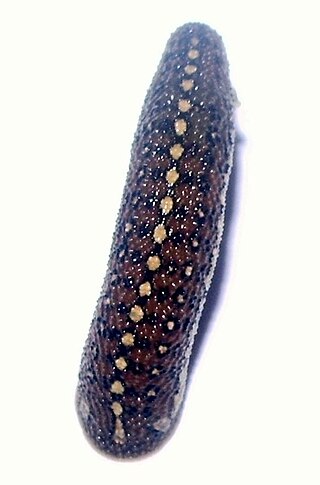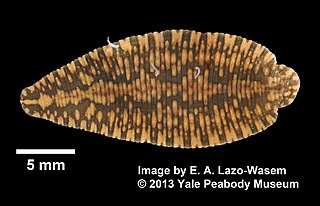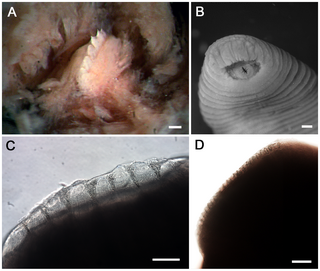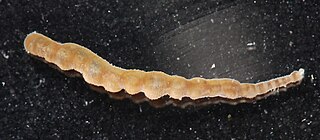
The Clitellata are a class of annelid worms, characterized by having a clitellum – the 'collar' that forms a reproductive cocoon during part of their life cycles. The clitellates comprise around 8,000 species. Unlike the class of Polychaeta, they do not have parapodia and their heads are less developed.

Haemadipsidae are a family of jawed leeches. They are a monophyletic group of hirudiniform proboscisless leeches. These leeches have five pairs of eyes, with the last two separated by two eyeless segments. The family is monotypic, containing only the subfamily Haemadipsinae, though as the family can apparently be divided into two or three distinct lineages, at least one of the proposed splits, while not a distinct family, might be a valid subfamily.
Erpobdella obscura is a freshwater ribbon leech common in North America. It is a relatively large leech and is commonly used as bait by anglers for walleye and other sport fish. In Minnesota, live bait dealers annually harvest over 45,000 kg of bait-leeches, raising concerns of over-harvest.

Helobdella is a genus of leeches in the family Glossiphoniidae, the freshwater jawless leeches. They occur worldwide.

Arhynchobdellida, the proboscisless leeches, are a monophyletic order of leeches. They are defined by the lack of the protrusible proboscis that defines their sister taxon, the Rhynchobdellida. Arhynchobdellida is a diverse order, compromising both aquatic and terrestrial, besides sanguivorous and predatory, leeches. The order is divided into two suborders, Erpobdelliformes and Hirudiniformes.

Leeches are segmented parasitic or predatory worms that comprise the subclass Hirudinea within the phylum Annelida. They are closely related to the oligochaetes, which include the earthworm, and like them have soft, muscular segmented bodies that can lengthen and contract. Both groups are hermaphrodites and have a clitellum, but leeches typically differ from the oligochaetes in having suckers at both ends and in having ring markings that do not correspond with their internal segmentation. The body is muscular and relatively solid, and the coelom, the spacious body cavity found in other annelids, is reduced to small channels.
Erpobdella lineata is a leech found in Europe. These leeches show a preference for calcic waters and have a tolerance to pollution. They have a digestive tract that consists of mouth, pharynx, esophagus, six-chambered stomach, three-chambered intestine, rectum, and an anus. Its nervous system contains 21 pairs of cell compartments.

Phytobdella catenifera is a large terrestrial leech found in Peninsular Malaysia. John Percy Moore chose this species’ epithet ‘catenifera’ after the striking chain-striped pattern on the creature's back.
Motobdella montezuma is a species of leech which is only found in Montezuma Well, central Arizona, United States. It is a nocturnal pelagic predator that feeds almost exclusively on the endemic amphipod Hyalella montezuma, which it detects using passive sonar and swallows whole.

Branchiobdellida is an order of freshwater leech-like clitellates that are obligate ectosymbionts or ectoparasites, mostly of astacoidean crayfish. They are found in the Northern Hemisphere and have a holarctic distribution in East Asia, the Euro-Mediterranean region and North and Central America, with the greatest species diversity being in North and Central America.

Erpobdellidae is a family of leeches. It is one of the four families belonging to the suborder Erpobdelliformes of the proboscisless leeches order, Arhynchobdellida.
Motobdella is a genus of leeches in the family Erpobdellidae. It contains two species:

Placobdella parasitica is a species of leech found in North America. Leeches are habitual ectoparasites of vertebrates in aquatic environments. Placobdella parasitica is differentiated from other members of the genus Placobdella by its smooth dorsal surface, simple to complicated pigmentation, and abdomen with 8 to 12 stripes.

Erpobdella octoculata is a freshwater leech in the Erpobdellidae family. This species can be found in Europe, the Mediterranean, and the Middle East.
Erpobdella triannulata is an leech in the Erpobdellidae family.
Erpobdella punctata is a leech in the family Erpobdellidae. It is found in freshwater streams and ponds in many parts of North America.
Erpobdella lahontana is a leech in the Erpobdellidae family.
Anna J. Phillips is an American Research Zoologist and curator of Clitellata and Cestoda at the National Museum of Natural History's Department of Invertebrate Zoology. As a parasitologist her research focuses on leeches and tapeworms, by studying their diversity, relationships, and host associations. She has traveled all over the world with her fieldwork to study the diversity of these invertebrates on a long range.

Praobdellidae is a family of hematophagous leeches which live on the mucous membranes of mammals and sometimes invertebrates. These are internal parasites that enter the body through natural orifices, and cause hirudiniases.

Myzobdella lugubris, the crab leech, is a species of jawless leech widespread in North America, especially in central and Eastern Canada. It is an ectoparasite of fish and crustaceans, and is responsible for several dangerous conditions in fish, including lesions infected by bacteria and fungi and possibly viral hemorrhagic septicemia. It lays its egg capsules on crabs and possible other arthropods, which then disperse the eggs.












